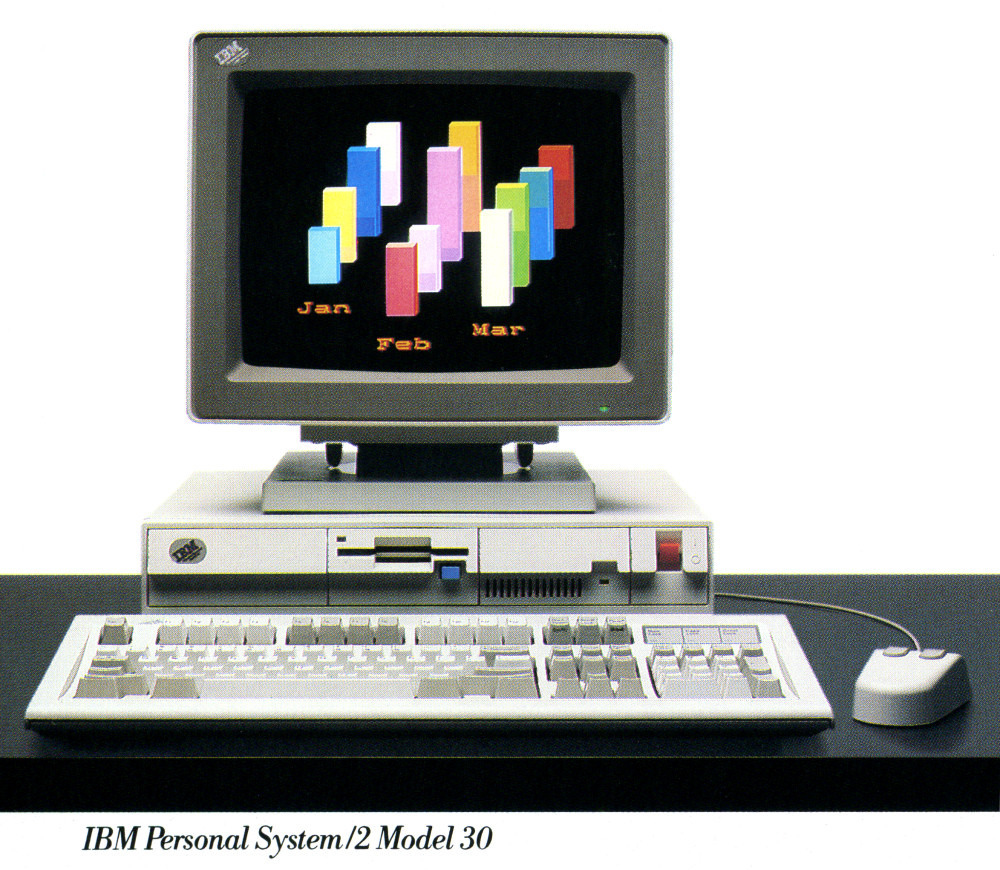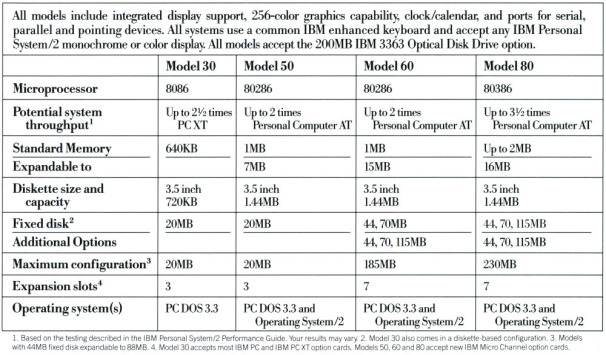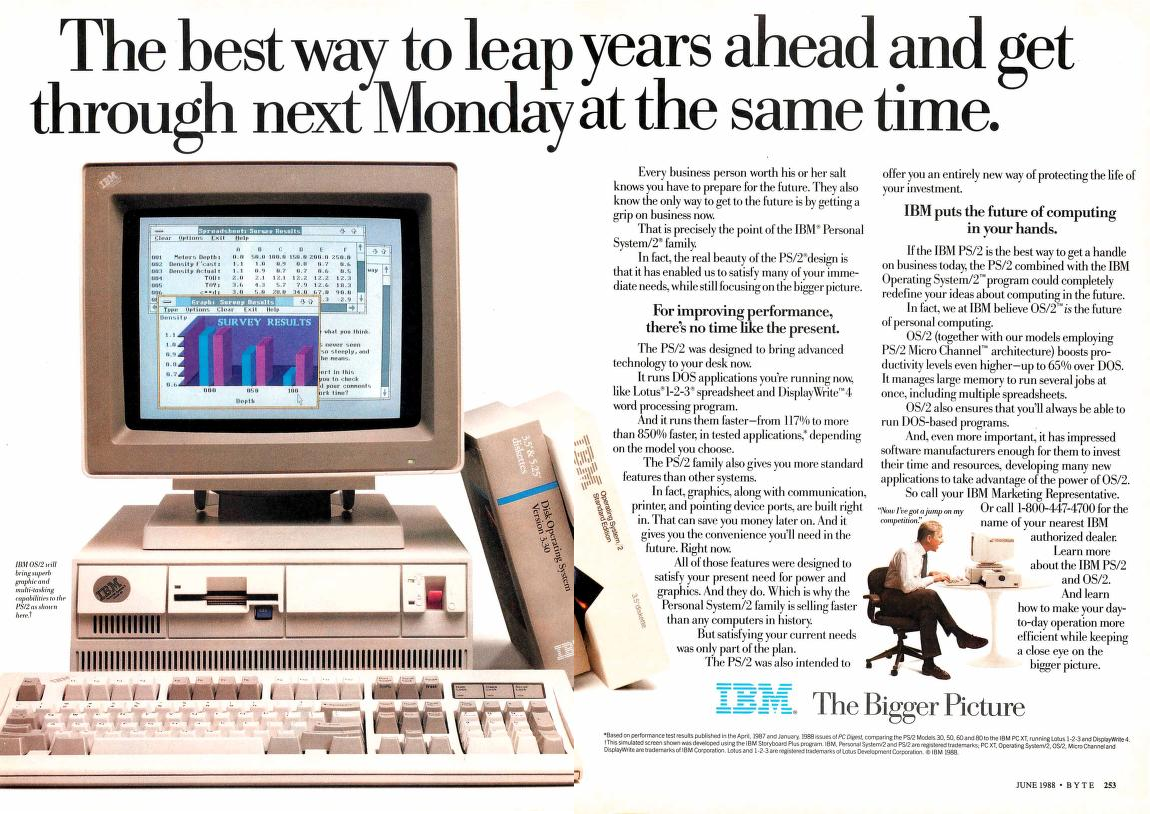IBM PS/2 Model 30
Introduction
IBM's PS/2 series of computers were launched in April 1987 with the Model 30. The line was introduced to replace the IBM PC, XT, and AT machines. Following these earlier machines, IBM realised their "one-size-fits-all" PC range was too stretched. They needed to fight back against the clone market where customers could get a PC tailored specifically to their needs. The PS/2 series was their answer to this, with an expansive range of machines with a variety of specifications to suit anyone and everyone.
The Model 30 (IBM Model 8530) was the lowest spec of the four originals, which comprised the Model 30, 50, 60 and 80. Designed to directly replace the IBM PC/XT, it came with an Intel 8086 microprocessor which clocked at 8 MHz with zero wait states, 640 KB of RAM, and a 3½" 720 KB floppy disk drive. An optional 20 MB ST-506 or 30 MB hard drive could be purchased. Several display options were available, including a 12" monochrome, or 14", 16" or 19" colour monitor. These drove the new MCGA display adapter.
As per the the IBM PC, XT and AT that went before it, the Model 30 came with 3 expansion slots on a riser card, although unlike the other three computers in the PS/2 range, the Model 30 came with a standard ISA bus. The Model 50 (a 286 desktop), Model 60 (a 286 tower), and Model 80 (a 386 tower) all got IBM's new Micro Channel Architecture (MCA) bus instead.
For the operating system, IBM launched OS/2 which was supposed to be the standard operating system for the PS/2 range, although it still supported IBM PC-DOS.
Here is the chart from an early magazine advert showing the specs of the four original PS/2 computers:
A sister model, the IBM PS/2 Model 30/286 was an enhanced version of the Model 30 that was released in September 1988. It came with an Intel 80286 processor clocked at 10 MHz, VGA graphics in place of MCGA, and 16-bit ISA expansion slots. Its model numbers were 8530-E01 and 8530-E21 which were the dual floppy and 20 MB hard disk version respectively.
Another similar model that was released after the Model 30 was the Model 25 - this had a built-in monitor and a more compact system unit, which made it far less expandable than the Model 30.
Sub-Models
IBM 8530-002 (640 KB, two floppy disk drives, keyboard) - list price $2,595
IBM 8530-021 (640 KB, one floppy disk drive, one 20 MB hard disk, keyboard) - list price $3,495
Optional Accessories
IBM offered the following options for the Model 30:-
- Personal System/2 8087 Math Co-Processor (#1501217)
- Personal System/2 Speech Adapter (#1501216)
- PC Network Adapter II (#1501220)
- PC Network Baseband Adapter (#1501221)
- IBM 2MB Expanded Memory Adapter (#2685193)
- Personal System/2 Display Adapter (#1887744) - IBM's name for what we would now refer to as standard VGA
- General Purpose Interface Bus Cable (#63X4882)
- PC Network Baseband Extender (#6134339)
- InfoWindow Enhanced Graphics Adapter (#56X2412)
- IBM Token-Ring Network PC Adapter Diskette (3.5 inch) (#67X0410)
- Personal System/2 5.25 Inch External Diskette Drive Adapter
- Personal System/2 Mouse (#6450350)
- IBM 3363 Optical Disk Drive (#63X4131, 63X4166)
- IBM Proprinter (#87X9787)
- Personal System/2 5.25 Inch External Diskette Drive (#4869001)
- IBM Quietwriter(R) II Printer (#1318200)
- Personal System/2 Data Migration Facility (#1501224)

An IBM PS/2 Advert from June 1988 (Byte Magazine)
Compatibility
Hardware - BIOS
The PS/2 line actually had two BIOSes. One, called ABIOS, or Advanced BIOS, was designed with the new MCA technology in mind. The second, called CBIOS, or Compatible BIOS, was in place to ensure the system would be fully "backward" compatible with IBM PC-DOS.
Hardware - MEMORY
The PS/2 line unfortunately do not use standard 30-pin memory. Instead they use a proprietary "IBM" type RAM which have a different pinout than regular 30-pin SIMMs. The originally supplied memory modules had silver cans on top of the chips. When replacing your memory, they don't have to be the metal can type ones - any SIMM with the right [IBM] pinout should work. According to the original IBM specification sheet, the RAM is: DRAM (MMK) 100-150ns w. parity.
Hardware - POWER SUPPLY
There are no Molex power connectors from the supplied 70W IBM PS/2 power supply. Instead all powered devices (floppy disk drives, hard drives, etc) use a proprietary fitting. The later Model 30-286 adds a further 4-pin power connector to supply voltage to the 16-bit ISA bus on those models. Aside from this, the same power supply can be used on the Model 30. The IBM PS/2 Model 55 PSU should also work as a drop-in replacement for the Model 30's.
Hardware - FLOPPY DRIVES
The high-density floppy drive wasn't even an option from IBM for the Model 30. Despite most XT-compatible PCs not supporting 1.44 MB floppy drives, a specific Sony-sourced 1.44 MB drive is known to work on the Model 30. You can tell if you have 720 KB floppy drives or 1.44 MB floppy drives by looking at the blue eject button. If it has '1.44MB' etched onto it, you know you have a high-density drive. If it's not there, it's a low-density drive. Apparently the external floppy drives actually have a BIOS extension and therefore work without any special drivers and are even boot-capable.
Hardware - HARD DRIVES
The Model 30's hard disk interface embedded on the motherboard is a proprietary affair. It is not ESDI as in later MCA-equipped PS/2s, nor is it standard MFM. The setup disk doesn't offer any other hard disk options other than the original HDD specs anyway, and the original drives were apparently quite failure-prone. There are only two or three models of drive that will work with this interface. The hard disk itself sits in a caddy in the Model 30.
HARDWARE - VIDEO
The Model 30 came with IBM's new MCGA (Multi-color Graphics Adapter) which pre-dated VGA. It supported the following modes:
40x25 text mode in 16 colours (8x16 character box)
80x25 text mode in 16 colours (8x16 character box)
320x200 in 256 colours, 70 Hz refresh rate - all points addressable
640x480 in 2 colours, 60 Hz refresh rate - all points addressable
Total palette of 262,144 colours.
Compatible with analog displays *only*.
Monochrome display sums colours to 64 gray shades.
Due to the Model 30's MCGA limitations later VGA games may not run properly - it is possible to install a third-party VGA ISA card, or even slot in an official IBM PS/2 Display Adapter which was the standard VGA card that came with the Model 30/286. The Model 30 uses the same internal connector and breaks it out to a 'standard' 15-pin DSUB, that can be used as a reference for the pinout. All 286 PS/2 systems came with VGA - only the 8-bit models came with MCGA.
The PS/2 Display Adapter, which was the VGA card that came with the PS/2 Model 30-286, was offered as an upgrade from early April 1987 with a price tag of $595. This added backward compatibility for MDA, CGA and EGA, and also worked with the new range of IBM analog monitors which comprised the 8503 (PS/2 Monochrome Display), 8512 (PS/2 Color Display), 8513 (PS/2 Color Display), and 8514 (PS/2 Color Display).
Other upgrade options made available at this time included the PS/2 Display Adapter 8514/A for $1,290. This 8514/A card could be further upgraded with the 8514/A Memory Expansion Kit which provided increased colour depths and grayscale support. All three upgrade options became available from June/July 1987.
HARDWARE - CPU
The CPU can be upgraded with an NEC V30 for a *significant* performance boost and ability to run some 286 instruction sets, although the V30 doesn't reports itself in software as a 286, so don't expect 286 performance.
Software
The PS/2 Model 30 came with a "Starter" disk, which was a system disk that booted into IBM PC-DOS. It had a set of utilities on it for configuring the PC as well as diagnostics. See the Downloads section for more details.
Physical
System Unit: 406 (W) x 397 (D) x 102 (H) mm
Weight: 8 kg (17.5 lbs)